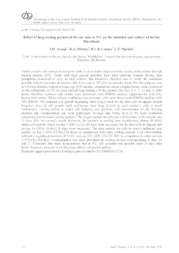Effect of long cooling periods of the ear skin at 5°C on the isolation and culture of bovine fibroblasts.
Effect of long cooling periods of the ear skin at 5°C on the isolation and culture of bovine fibroblasts.
Author(s): ARAUJO, J. M.; OLIVEIRA, R. A.; CUMPA, H. C. B.; MARTINS, C. F.
Summary: Viable somatic cell storage in cryogenic tanks is an essential step on bovine cloning achievement through nuclear transfer (NT). Cattle with high genetic potential have died suddenly without having their germplasm conserved in vitro. In such context, this research’s objective was to verify the maximum possible time for isolation of somatic cells to be used in NT after an animal’s death. For this purpose, ears of 6 Nelore females with an average age of 48 months, obtained in a local slaughterhouse, were conserved on the refrigerator at 5°C in clean ziplock bags during a 30 day period. On days 2, 4, 7, 14 and 21 after death, fibroblast isolation and culture were performed with DMEM medium supplemented with 10% bovine fetal serum. When cellular confluence was detected, cells were frozen with DMEM medium with 10% DMSO. We analised cell growth beginning (how long it took for the first cells to appear around biopsies), time of cell growth until confluence (how long it took to each animal’s cells to reach confluence), cooling period in which cell isolation was possible, cell concentration on the freezing moment and contamination rate were performed. Average and Tukey tests at 5% were conducted comparing data between cooling periods. The longest period that allowed cell isolation in all animals was 14 days after the animal’s death. However, the increase in cooling time significantly altered (P<0.05) initial cell growth, where on day 4 (D4) 4.33±1.03 days were necessary for the first cells to appear, and on day 14 (D14) 19.60±2.19 days were necessary. The time needed for cells to reach confluence was smaller on day 2 (D2) (28.00±3.10 days) in comparison with other cooling periods. Cell concentration suffered a significant decrease (P<0.05) only on D14 (698.125±131.203) in comparison to other periods (1.571.656±234.462). Contamination was more prevalent on cooling periods corresponding to days 14 and 21. Therefore, this study demonstrated that at 5°C, cell isolation was possible until 14 days after death. However, increase in cooling time affects cell growth pattern.
Publication year: 2018
Types of publication: Abstract in annals or event proceedings
Unit: Embrapa Cerrados
Observation
Some of Embrapa's publications are published as ePub files. To read them, use or download one of the following free software options to your computer or mobile device. Android: Google Play Books; IOS: iBooks; Windows and Linux: Calibre.
Access other publications
Access the Agricultural Research Database (BDPA) to consult Embrapa's full library collection and records.
Visit Embrapa Bookstore to purchase books and other publications sold by Embrapa.

